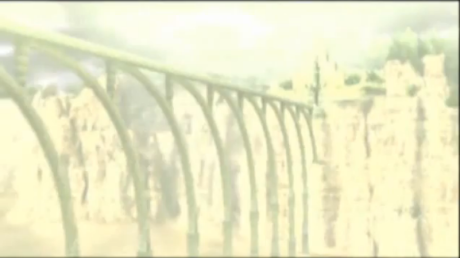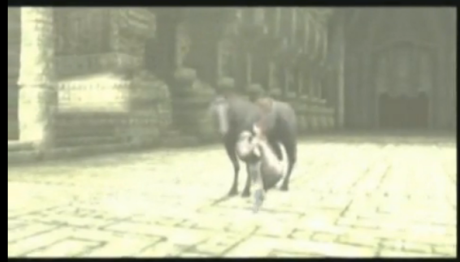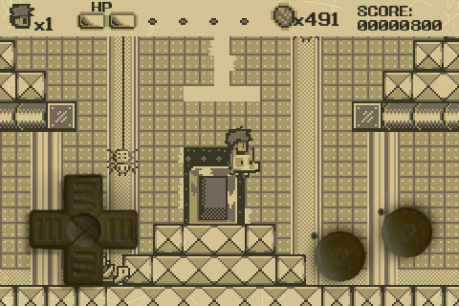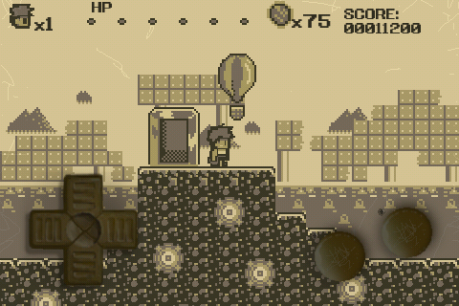There’s plenty of great games that, for one reason or another, passed me by during the course of my existence. Shadow of the Colossus? One of those games. And now since SOTC comes up in almost every discussion on “video games as art” or as film or as an example of good design, I’m pressed to sit down and finally play it.
First of all, if you haven’t played it yet, WHAT ARE YOU WAITING FOR GET A COPY AND A PS2 AND PLAY IT ALREADY!! ^__^ No, seriously. You’re missing out. Now then..

Shadow of the Colossus starts with a very long cutscene that plays like a film, despite its graphical rust. We see a man on a horse climbing a precarious ledge, and then follow him to a huge bridge over a canyon. This opens up a few questions: Who is this man (boy?) on the horse, where is he going, and most importantly, where did he come from? As far as I’ve played, not all of these questions are answered, though we do learn where he is going. This leads to the first lesson of Design Theatre:
#1. Open with questions.
In case you’re designing a game with its own story and world, take a lesson from SOTC and open with questions, easing the player into their place in the world, while simultaneously immersing them in it. Half-life 1 and 2 do this: the player starts on a tram car, with someone talking, and while this dialogue alludes to events in the game world, it opens up many more questions than it answers. The original Halo also does this, with Captain Keyes and the AI Cortana exchanging dialogue without speaking to the player directly. In fact, even Braid does this, opening with the protagonist silhouetted against a burning city: why is it burning? Where am I? The answer to Braid’s question is answered at the end of the game, which nicely transitions back to the burning city after the epilogue, concluding the narrative and making the game seem complete.

Going back to SOTC, the opening cutscene then fades out perfectly into the title screen – it does not upset the mood of the game by fading to a black screen with a spinning logo, as was – and sadly still is – a cliche of console and pc games. Portal 2’s story was fantastic, but the proliferation of loading screens was downright ridiculous. When designing a game with loading screens, please don’t upset the carefully-crafted mood of the game each time a load screen pops up, or the bulk of the game’s content will be lost in the moments after the load screen as the player tries to recollect their composure. So I’m making this the second lesson of Design Theatre:
#2. Never let load screens upset the mood of the game: hide load times whenever you can.
This is an oft-overlooked lesson. Say what you will about Apple, but if they ever made a game, be sure that minimal load screens would be a top priority. Why? Because Apple cares not just the product, but the presentation of the product, and treats both equally. For those who played the original Mass Effect, the infamous elevator scenes – where the player had to ride extremely slow elevators that masked level loads – are NOT what I mean when I say “hide” a load screen, since some players knew they were waiting for a level to load. SOTC hides its loading from the player extremely effectively, as there are little to no load screens during the course of the game. (You might have not noticed the game loaded anything at all!)

When our hero finally steps off his horse, we see him carry a girl (who looks his age) to what is presumably an altar, and sets her there. What is interesting about this scene is that you may not have noticed the girl at all until this moment, which serves to renew interest in the story after a quite lengthy opening sequence. It is implied through an anonymous talking mask that she is dead, and our hero has ventured into the land of the colossi, (that was apparently so dangerous a giant bridge was built over it) apparent immortals whose physical incarnations can only be killed by a mortal with an ancient sword, which our hero conveniently yields. Here, our questions start to be answered, but more questions are raised.

The scene is actually a cleverly-disguised tutorial section, which explains to the player the goal of the game (kill all 16 colossi to bring a dead girl back to life), foreshadows the shadow spirit’s role in the story, provides narrative incentive to play the game (“But read this, the price you pay may be heavy indeed.” What price? Death?), and tells the player that the sword is important to gameplay (“Raise thy sword by the light”). This leads to the third rule of design theatre, which is relevant to story-based games:
#3. Intertwine the tutorial into the story. The meaning of important plot objects should parallel their meaning during gameplay.
For example, the opening cutscene shows the player that they are alone with their horse, who enables them to travel long distances together – exactly what the horse is used for during the course of the game. The idols need to be destroyed — the colossi need to be destroyed. The sword allows our hero to hold some power — only the sword can kill the colossi.

Once the player moves on to the first area, we must leave Agro (the horse) behind, and climb our first wall. When I first got to this section my friend and I couldn’t figure out where to climb up, but once we discovered that the moss can be climbed, every other climbing area was relatively easy. What we didn’t know at this point was that the visual distinction of climbable surfaces (furry materials) shows the player how to defeat the first colossi, without telling them directly: climb up the fur on his feet. Notice that the designers could have shown us the first colossi and then told us during the course of battle that “fur can be climbed,” or even show us (by panning the camera or something), but instead make us show ourselves before the first battle even begins. This is our fourth lesson:
#4. When introducing a new gameplay mechanic, let the player show themselves how it functions.
The ability to let the player show themselves how or why something is separates games from film and books. It seems natural that the progression of entertainment goes something like so:
- Books tell the reader; they speak directly to the reader, but they can only produce imperfect images because every human interprets words differently. English teachers tell you it is better to show than to tell in stories, which comes naturally to films.
- Films show the viewer (if they are good films!); they show the viewer exactly what they mean, but the visual conception of the world is usually concrete. Great films usually go against the viewer’s visual conception of the world that the protagonist lives in – in Taxi Driver, (spoiler alert) this is when De Niro shaves his head into a mohawk, tries to kill a politician in an army jacket and then goes on a violent rampage. In The Shawshank Redemption, this is when Andy reveals that he’s been carving an escape passage behind his pin-up posters.
- Games let the player show themselves; the player, through experimentation and logical thought, can deduce the meaning and function of elements in the world. In level 1-1 of Super Mario Bros., you know to jump on Goombas to defeat them, use Mushrooms to grow and hit ? blocks to uncover power-ups and coins. None of this is told to the player from a third party – the player discovers the world for themselves.
This marks the end of Part 1 — but don’t worry! ^__^ Part 2 is on the way! Whereas Part 1 focused heavily on story and the first steps of a game, Part 2 will focus on the colossi battles and their presentation.








